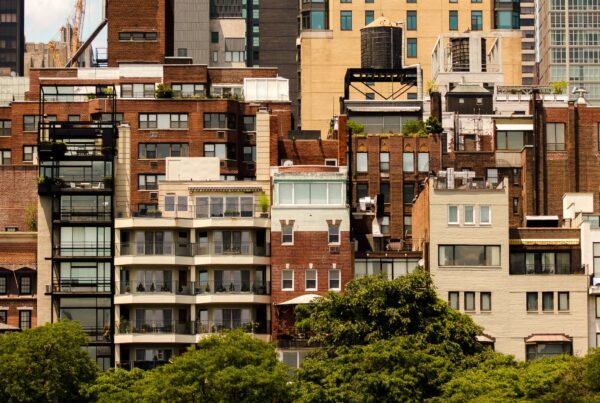5 Questions YOU Should Ask Post 2019 Rent Reform
07/31/2019
Living in NYC will be dramatically reshaped. The “2019 Rent Reform Act” immediately implements state-wide rent caps on rent stabilized apartments and more strict landlord controls, as the government vastly increases its power over these buildings. The political change which allowed the bill to pass, was created when Democrats took control of the New York State Senate, which has been typically held by Republicans. In a way, this change is the result of “anti-trump” votes that flipped those senate seats in the mid-terms of 2018. This effectively created a 1-party rule throughout New York.
There are approximately 20,000 multifamily building owners in NYC. There are short-term, long-term, and unintended consequences, that rent reform will have on New York. What should you, as a property owner, do next?
To gain a better understanding, we conducted a survey of thousands of NYC property owners asking them how they were internalizing the new laws. What are their plans and new priorities? The interesting results are spread throughout this article along with our insights. What are the 5 questions you, a property owner, should be asking yourself today?
1. What’s my Asset Worth?
With this new law, the investment market for rent stabilized buildings flips from a “future cash flow” business to a “current cash flow” business. This happened with a stroke of Cuomo’s pen, and instantly changed the way investors value those assets. While most owners were prepared for the rent laws to change (and impact business negatively), 90% of the surveyed owners (90% is not a typo) felt the laws were worse than expected. There’s a Black Swan quality to it.
Rent Stabilization always required owners to lease units at rates below market value and ensure mandatory lease renewals. But the new law removes any mechanism to eventually bring those units to market rents. With this fundamental shift, properties with stabilized units face an immediate value loss. What does that mean for your assets? The more stabilized units in a building, the bigger the impact. In some cases, properties may lose up to 40% of their value, although many will be in the 20%-30% range.
For owners’ equity there is a rub. When values go down by 20%, the owners’ equity actually goes down by more (roughly a factor of 2X the % value loss). For example, say a building is worth $100, has a $60 loan, and $40 of equity. If the value goes down by 20% (from $100 – $80) the owners’ loss of equity is actually 50%!
Overall, though tenants celebrate regulations, those in the industry warn this is short sighted and a hangover to the party is coming. They believe ugly consequences will follow for all city residents.
To be sure, no one wins in a city where residents cannot afford housing. And no one wins in a city where the housing stock is suffering. It’s not either/or. Once in effect, rent reform has implications that reach far beyond the interests of tenants and owners. 76% of the owners we surveyed believe the situation in NYC will be worse 10 years from now.
As all buildings with stabilized units have seen values go down, and the degree of impact depends on the number of stabilized units, and the delta between the market rent and average rent of all the stabilized units in the building. This also has a huge impact on financing as we found that over 60% of owners plan on changing their financing strategy as a result of the bill. It’s safe to assume they are not taking out bigger loans to make renovations, upgrades, and create jobs.
2. How Should My Management Strategy Change?
One of the most confusing aspects of this law is understanding how it will damage the housing quality for lower income tenants and other residents. In short, when normal business incentives are reversed, normal business goals of serving the customer are turned upside down. Owners are now incentivized to spend as little as possible in unit renovations, common areas, and public facing areas of their buildings. If there is no way to recover the money it takes to make these improvements, owners will not do them. The average building this law applies to are often referred to as “pre-war.” This means they were built before WWII. These assets are old and need constant work.
Tenants will have no choice but to live in units and buildings that just pass what is required by law. Units that would otherwise be new and improved will feel like they’re frozen in time. This is what friends tell me it’s like in Cuba. True, the rent will be frozen, but residents pay the price in quality of life (I discuss other ways rent stabilization hurts tenants in Family Secrets).Owners understand this better than anyone— 90% of survey owners agree that this new legislation will have a negative impact on quality of living.
A whopping 65% of survey respondents indicated they would now spend as little as possible on renovations, and as many as 27% claim they’ll keep units vacant rather than renovate. Units that would have been improved between tenants will stagnate, if they’re put on the market at all. This reduces supply and lowers quality. The rules are what they are, and your management strategy should limit expenses where possible.
3. What is my investment time horizon?
Neighborhoods don’t revitalize without good housing. NYC has benefited from tremendous growth as neighborhoods and boroughs all throughout have opened up and become viable options for living. Compare NYC in 2019 with Brooklyn and the Bronx in the 1970s. Properties, without the financial resources to maintain them, will become an eyesore. It’s not just the appeal of the building itself that will decrease— dilapidated properties will decrease the value of the neighborhood, too.
Several economists have repeatedly opined that the only sustainable way to reduce housing costs is to increase the rental supply. This law was intended to increase the supply of affordable housing (by making it impossible to remove units from rent stabilization), but our research indicates it will have the opposite effect. Owners want to increase cash flow. Those managing units will likely respond in many ways, but here are three examples:
1. Because of new restrictions limiting how owners can recover the cost to renovate vacant units, many landlords will elect to keep units vacant instead of renovating them. For instance, most stabilized tenants have lived in those units for 15+ years. Updating and preparing those units for occupancy is expensive. With no way to recover the renovation costs, owners are actually financially incentivized to keep them vacant! Empty units won’t make money, but— more importantly—they won’t lose money.
2. Owners are left to use any means necessary to raise rents. One option is to combine two units into one. When owners do this, they are allowed to set a new higher rent at market levels. Even though this new rent will be stabilized, it is one way to increase a buildings income. The unintended consequence: a unit was just removed from the housing supply.
3. In the past, it was the owners—not the government—who were incentivized with identifying tenant abuse of the system. If a tenant was occupying a stabilized unit illegally, they would move to remove the tenant. Now, though, owners don’t have a reason to keep tabs on their residents. If they won’t profit from it, what’s the point? Property owners will simply turn a blind eye. Manipulative tenants will be able to hold their units for as long as they please, and those who really, truly need them will have less supply to choose from.
Clearly the management game has and will change and we recommend that you take time now to reflect upon your time horizon. If its 10-20 years you will look at these laws differently than if you were planning on selling in the next 10. How long do you plan on owning these assets?
Free Market
If there is one group that possibly wins from this law it would be the owners of free market units. Free market buildings, uninhibited by stabilized rent caps, may become more valuable as those owners continue to lease units at market rents, even if they rise, and operate the buildings as they choose. As such, they’ll be able to maintain their cash flow, make continued renovations, and uphold the overall value of their property.
In fact, we may see a rise in free market rents as there will now be no “newly renovated” units added to the rental supply. Before this law was in place, stabilized units which became vacant (in neighborhoods that could support the investment) would be gut renovated, improved with the best amenities, brought to free market status, and leased at market rents. In most cases, during this renovation the unit was also being reconfigured to increase the occupancy –(think of it: upgraded housing quality, job creation, and increased supply all in one). One bedroom units were converted to three bedrooms, two’s were reconfigured to fours and so on. As a result, for residents moving to NYC (or to a new neighborhood) they had more rental options, because supply was increasing. Recently, to the benefit of NYC renters, market rents were decreasing ! Proving that when you add supply, rents go down.
This method of increasing the supply of free market rents is now gone–and all the jobs. Investors who understand this, understand that when you limit the supply, prices go up, and therefore free market rents in NYC are now poised to go up further. For this reason, now is the time to look at free market assets even more closely.
To take a deep dive into the recent changes made to the rent laws in New York, listen to our 2019 Rent Law Series on Behind the Bricks Podcast.
4. What is My Current Return on Equity?
Property owners are generally looking for three things: less complexity, more free time and increased cash flow. Your real estate investment is a tool you use to achieve those means. Part of this is understanding your return on equity (ROE). This can be found by dividing your net cash flow by your current equity (market value less mortgage). For example:
Some owners mistakenly calculate the ROE based on the purchase price, not today’s value. To accurately analyze, you have to use the current market value. Let’s assume the above property’s value has increased to 10 million, but the cash flow has not. In that case, the current return on equity is no longer 10%, but only 1%. If you are one of these owners, repositioning your equity (making 1% above), into an asset that produces even a 5% return can increase your net cash flow 5X! As values have changed in NYC, all owners should be assessing this aspect of their holdings when thinking about the future.
5. How can I support the industry?
The final question owners should be asking is: how can I support the industry? On a philosophical level, this law reflects the convergence of several local, national, and global trends. The housing crunch, political divide, impacts of technology, and wealth gap are all at play here. Should private citizens who own apartment buildings, be held responsible for paying for housing subsidies? If they are, should the government compensate them? Or is it correct to believe that property owners “should pay for it” because they “already have enough“?
The legislation is laden with short and long term consequences. Despite the good intentions, the law may hurt those it was designed to help. Further, it will impact all NYC residents as the quality of housing deteriorates throughout the city. You cannot have “neighborhood revitalization” without good housing, and the private business community is the only group that can pay for and provide it–if they are allowed. Before there was the revitalization of Brooklyn in the 2000’s, there were parts that were uninhabitable in the ’70s, ’80’s, and 90’s. All NYC residents suffered then.
We believe to improve the lives of tenants, the government would work to massively increase supply, and encourage more low income home ownership. When lower income residents are given the opportunity to become home owners, the quality of the neighborhoods improves, schools improve, communities improve and they enter the path towards building wealth and moving up the economic ladder.
As reported in many papers the ownership organization Community Housing Improvement Program, CHIP, has filed a lawsuit questioning the legality of rent stabilization. If owners want to support the industry, contacting CHIP and RSA would be good places to start.
NYC is commonly referred to as the “capital of the world.” We hope that public and private sectors can come together so all that “capital” can be put to use correctly, for the benefit of all.
facebook LinkedIn Instagram Twitter





Landlords come out the losers after rent reform changes of 2019
Those of us with stabilized + free market unit buildings still have to keep investing in the property in order to keep the vital free market tenants without whom we would go out of business.
Also NY is supposed to be encouraging home ownership but by practically eliminating the coop/condo process, tenants will no longer be able to purchase their units (at discount insider prices) and will remain tenants in decaying units, probably for the rest of their lives.
Finally it should be pointed out that the city is forcing huge new expenses on us, at a time when our antique but so far well-maintained building needs a lot of ruinously expensive updates and capital improvements- which we will never be able to recoup.
These new laws effectively amount to asset dispossession and should be declared unconstitutional. By the way, our mayor’s rental properties are still free market and totally uncontrolled!
What should my partner and I do? We were marketing our buildings for sale when these laws went into effect. A sale of C-CORP shares, a 1031 exchange, ornam outright sale? My sister and I are in our seventies. We wish to be out of this business ASAP. Neither of us wants to hang around and see if the lawsuit CHIP and RSA succeeds or not.
Let me know how other landlords fee.
We are in the process of getting a managing agent to run the buildings.
Please help us.
We are at an intersection and every owner will have to personally decide whether they want to sell and be done with it all or buckle down and hang on for another 10-15 years when these laws will revert back/change to some resemblance of pre-June 2019. In short, if you can see yourself holding for another 10-15 years, keep your property. If not, sell.
You neglect to mention that although the value or our buildings and our income is being reduced, City taxes continue to increase (8%) almost annually as does fuel costs, con Ed, insurance, maintenance, etc. and new yearly city mandates that increase our expenses as well
There are more tenants than landlords. Democrats are desperate for votes.
These liberal policies will be devastating to New York City, which will soon become an other Baltimore, Chicago or Detroit.
These policies are also destroying beautiful cities like Los Angelos and San Francisco.
Why don’t all property owners form a union and strike (stop paying re taxes and water). What would the city do? Foreclose on all the buildings?